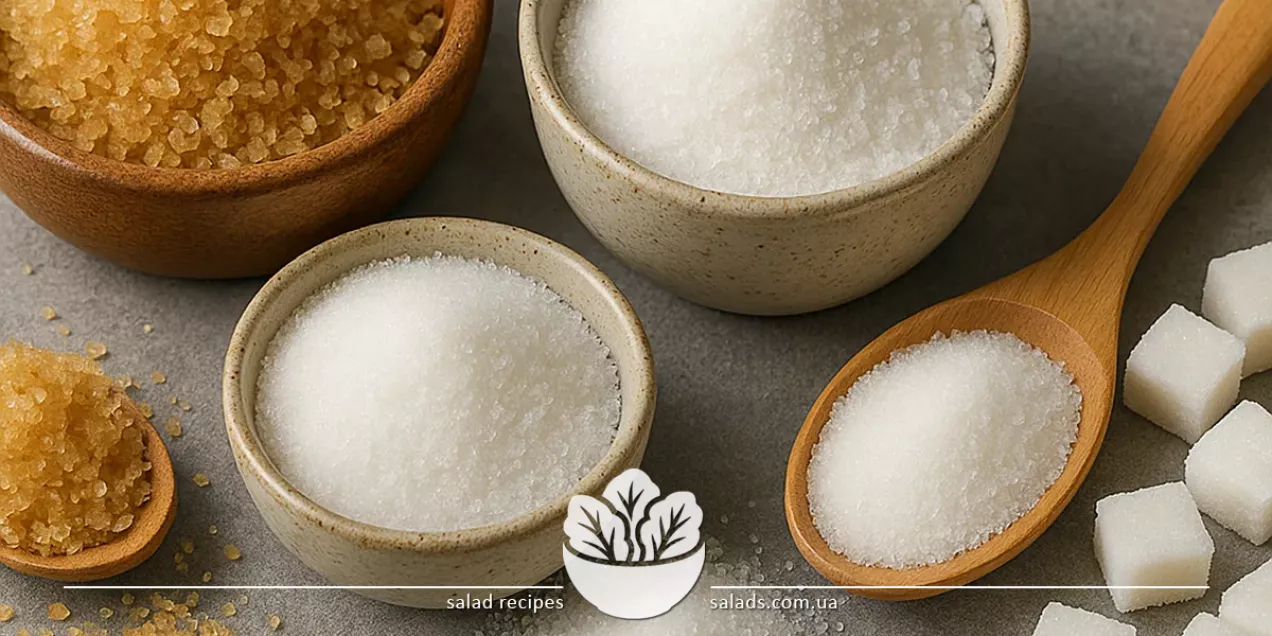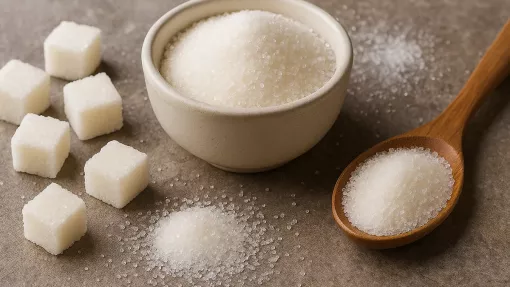Sugar

Sugar is not just a sweet additive but an essential component of cooking that performs the roles of sweetening, caramelization, preservation, and even structuring. There are many types of sugar: white beet, cane, brown, muscovado, demerara, coconut, as well as powdered sugar and syrup. Each type has its own properties and uses – from caramel to pastries and beverages. In recipes from different cultures, sugar is used not only in desserts but also in meat dishes, sauces, and marinades. Learn more about other seasonings in the spices category.
Different Types of Sugar
Sugar Varieties and Their Culinary Properties
Sugar isn’t just white and sweet – dozens of varieties are used in cooking, each with distinct flavor, technical, and aromatic characteristics. The most common is white granulated sugar, derived from beet or cane. It is versatile, dissolves easily, and works well for baking, beverages, sauces, and creams. In recipes, when “regular” sugar is mentioned, this is usually what’s meant. Brown sugar retains molasses, which gives it a distinct color, moist texture, and caramel flavor. It’s perfect for cookies, sauces, marinades, and some meat dishes. Its varieties – muscovado, demerara, turbinado – vary in sweetness and aroma. Cane sugar can be either white or dark and is often used in cocktails, baked goods, and Asian cuisine.
Powdered sugar is finely ground sugar added to glazes, creams, desserts, and drinks. It dissolves instantly, making it ideal for whipped egg whites and delicate textures. There’s also vanilla sugar, flavored with natural or synthetic vanilla. It gives dishes a pleasant aroma and is often used in baked goods. For decoration, large-crystal or colored sugar is used – especially in festive desserts. In some spice blends, sugar balances spicy elements such as pepper. In such combinations, sugar doesn’t just sweeten but adds depth and smooths out the aggressive notes of seasonings.
The Role of Sugar in Baking, Desserts and Drinks
Sugar plays a key role in desserts, doughs, and beverages not only as a sweetener but also as a structuring agent. During baking, it interacts with fats, proteins, and starch, affecting the texture and color of the final product. Sugar participates in caramelization – a process that forms a golden crust and adds a pleasant taste and aroma to baked goods, casseroles, and some meat dishes. In dough, sugar serves another function – feeding yeast to promote fermentation. This is crucial for airy texture in sweet breads, cakes, and rolls. In whipped egg mixtures, it stabilizes the foam, preserving volume and lightness – as seen in meringues, soufflés, and whipped creams. In ice creams and cold desserts, sugar lowers the freezing point of the mixture, creating a softer and smoother texture.
In beverages – both hot and cold – sugar not only softens the flavor but also helps release the aroma. This is especially noticeable in tea with lemon, compotes, cocoa, or coffee-based drinks with spices. In cocktails, cane sugar or its syrup balances acidity and alcohol, creating a fuller taste. In dairy-based desserts with cheese or yogurt, a small amount of sugar softens acidity and results in a more harmonious flavor. In complex flavor recipes – such as sauces or glazes – sugar pairs with salty, sour, or spicy components. That’s why it’s often added to dishes that contain salt, helping achieve a perfect flavor balance. Even in meat or vegetable dishes, a touch of sugar can significantly enhance the overall taste.
Sugar in Cuisines Around the World
Sugar is a universal ingredient, but each world cuisine uses it differently. In French tradition, it features in classic desserts like crème brûlée, tarte Tatin, éclairs, and meringues. Here, sugar is not only for sweetness but also essential for texture, caramel, and delicate creams. In Mediterranean cuisine, it’s used in almond pastries, fruit salads, and sweet syrups that soak sponge cakes or cookies. In the Middle East, sugar is used for sherbets, halva, and baklava – combined with nuts, honey, and spices. In India, it’s found in milk-, mango-, or rice-based desserts, as well as in sauces for spicy meat dishes. In Chinese cuisine, caramelized sugar is often used to create a glossy glaze on pork or duck and in marinades.
Sugar is also a key component in sauces, where it balances acidity, bitterness, or heat. In soy or sweet-and-sour sauces, its role is to soften, deepen, and round out the flavor. In Thai or Vietnamese dishes, sugar is often combined with fish sauce, lime juice, and chili to create layered flavor profiles. Ukrainian cuisine also deserves mention: sugar is added to pancakes, dumplings, crepes, stewed fruits, and kutia. In combination with poppy seeds, dried fruits, cream, or cheese, it creates the traditional flavors of childhood. Festive dishes often include aromatic sweeteners like vanilla sugar, caramel, or condensed milk. A similar taste balance can be achieved with soy sauces, which, when paired with sugar, form a rich culinary composition even in simple dishes.
Storage, Selection and Use of Sugar
Sugar has a long shelf life but requires proper storage. Crystalline varieties – both white and cane – should be kept in airtight containers in a dry, cool place. Moisture is the main threat: it causes sugar to clump, lose its free-flowing texture, and form lumps. This is especially important for brown sugar, which contains molasses and is highly hygroscopic – it dries out or sticks together quickly if stored improperly. To preserve its texture, brown sugar is sometimes stored with a ceramic disc or a piece of apple to maintain humidity. Powdered sugar should be kept separately in a sealed container, away from heat, to prevent moisture absorption and caking. When buying, look for uniform color, no lumps, and no off odors. Vanilla or flavored sugar is best purchased in sealed packaging or made at home by storing a vanilla pod in sugar.
Sugar usage should be carefully measured. Too much can overwhelm other flavors and make the dish heavy or overly sweet. This is especially true in recipes already containing natural sweeteners – fruit, honey, caramelized onions. Often, a small amount of sugar is enough to create a balanced flavor. For example, in sweet sauces or glazes, combining sugar with onion works well – its natural sweetness boosts the caramelization effect and creates a complex flavor profile. This is especially valuable in recipes with meat, vegetables, or grain-based sides.
Sugar Alternatives and Flavor Balance
Although sugar remains a staple sweetener in cooking, it’s increasingly being replaced – for health reasons or to create new flavor combinations. Popular substitutes include honey, maple syrup, molasses, date paste, agave syrup, and coconut sugar. Each differs not only in sweetness but also in aroma, consistency, and effect on the texture and color of dishes. Honey, for instance, provides a floral or herbal note and pairs well with dairy, baked goods, tea, and sauces. In desserts where density and caramel flavor are essential, molasses or thick syrups are often used – they create a moist dough or elastic texture. In vegan recipes, agave syrup or date paste is popular – used in smoothies, bars, and sugar-free baking.
In complex flavor recipes, a single sweetener may not be enough. That’s why chefs often combine classic sugar with other ingredients – spices, acids, salt, or sauces. A balance of sweet and salty adds depth to the dish. Examples include sugar with pepper for spiciness and expression, or with vinegar to create a distinctive sweet-and-sour profile. The form of sugar is also important: crystalline sugar works well for structure, while syrup or powdered sugar is better suited to liquids and delicate mixtures. Choosing the right type and amount of sugar is not just about taste – it’s also a technical factor that impacts the final outcome.
